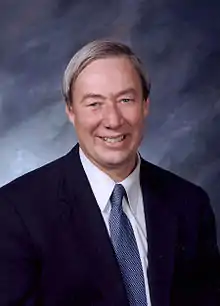William K. Sessions III
William K. Sessions III (born 1947 in Hartford, Connecticut) is serving as a Senior United States District Judge of the United States District Court for the District of Vermont and has served as the Vice Chair and eventually as Chair of the United States Sentencing Commission. He was confirmed on October 21, 2009 as Chair of the United States Sentencing Commission, and served until December 22, 2010.[1]
William K. Sessions III | |
|---|---|
 | |
| Senior Judge of the United States District Court for the District of Vermont | |
| Assumed office June 15, 2014 | |
| Chair of the United States Sentencing Commission | |
| In office 2009–2010 | |
| Appointed by | Barack Obama |
| Preceded by | Michael E. Horowitz |
| Succeeded by | Patti B. Saris |
| Chief Judge of the United States District Court for the District of Vermont | |
| In office 2002–2010 | |
| Preceded by | John Garvan Murtha |
| Succeeded by | Christina Reiss |
| Vice Chair of the Sentencing Commission | |
| In office 1999–2009 | |
| Succeeded by | Charles R. Breyer |
| Judge of the United States District Court for the District of Vermont | |
| In office August 14, 1995 – June 15, 2014 | |
| Appointed by | Bill Clinton |
| Preceded by | Fred I. Parker |
| Succeeded by | Geoffrey W. Crawford |
| Personal details | |
| Born | William K. Sessions III 1947 (age 73–74) Hartford, Connecticut |
| Education | Middlebury College (B.A.) George Washington University Law School (J.D.) |
Education and career
Sessions was educated at Middlebury College where he earned a Bachelor of Arts degree in 1969. He earned a Juris Doctor in 1972 from the George Washington University Law School. Sessions served as a United States Army First Lieutenant. He was a law clerk for Judge Hilton Dier in Addison County District Court in 1973. He later worked for the Addison County Public Defender before entering private practice in 1978. He also worked as an adjunct professor at Vermont Law School from 1978 until 1995. In 1992 he managed the successful reelection campaign of Senator Patrick Leahy, who defeated Jim Douglas.
Federal judicial service
Sessions was nominated by Bill Clinton on June 30, 1995, to a seat vacated by Fred I. Parker. He was confirmed by the Senate on August 11, 1995, and received his commission on August 14, 1995. Sessions served as chief judge from 2002 to 2010. He assumed senior status on June 15, 2014.
Notable case
On September 12, 2007, Judge Sessions ruled in favor of the Sierra Club, the states of Vermont and New York, and other environmental groups in rejecting the auto industry’s attempt to block states from regulating emissions from cars. Sessions' ruling opens the doors for New York and Vermont to proceed with enacting the California Clean Car (Pavley) Standards, pending United States Environmental Protection Agency approval. These standards, adopted by California and at least 11 other states, aim to reduce emissions from cars by 30 percent when fully implemented in 2016. This precedent will likely have an important impact on similar cases pending in California and Rhode Island.[2]
Sentencing commission
On April 20, 2009, President Barack Obama nominated Sessions to be Chair of the United States Sentencing Commission.[3] Sessions' nomination languished with no full Senate vote for more than six months, with Senate Majority Leader Harry Reid contending that Senate Republicans had stalled Sessions' nomination in retaliation for the speed of Supreme Court Associate Justice Sonia Sotomayor's confirmation process.[4] Reid filed cloture on Sessions' nomination on October 20, 2009, and the Senate confirmed Sessions in a voice vote on October 21, 2009.
References
- "Former Commissioner Information". United States Sentencing Commission.
- "Sierra Club website".
- States Sentencing Commission Nomination
- "Obama Taps Another MoFo Lawyer". The BLT: The Blog of Legal Times.
Sources
- William K. Sessions III at the Biographical Directory of Federal Judges, a public domain publication of the Federal Judicial Center.
| Legal offices | ||
|---|---|---|
| Preceded by Fred I. Parker |
Judge of the United States District Court for the District of Vermont 1995–2014 |
Succeeded by Geoffrey W. Crawford |
| Preceded by Unknown |
Vice Chair of the United States Sentencing Commission 1999–2009 |
Succeeded by Charles R. Breyer |
| Preceded by John Garvan Murtha |
Chief Judge of the United States District Court for the District of Vermont 2002–2010 |
Succeeded by Christina Reiss |
| Preceded by Michael E. Horowitz |
Chair of the United States Sentencing Commission 2009–2010 |
Succeeded by Patti B. Saris |